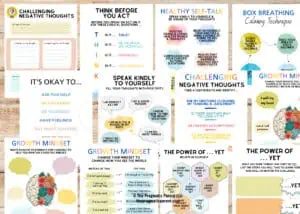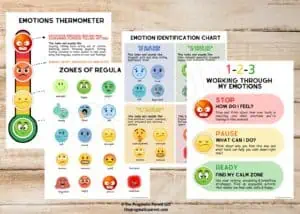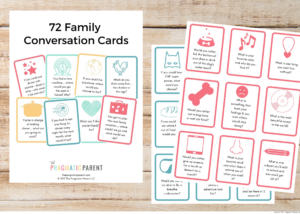What to do when baby won’t nap or baby won’t nap unless held. 8 common reasons why your baby doesn’t nap and tips to get your baby taking naps, again! Plus, if you’re in the middle of a sleep regression, what to do!
Help! My Baby Won’t Nap
Babies need their naps – all of them – until they’re about four years old when it’s time to give them up. Some kids even make it to Kindergarten still napping, but when your baby won’t nap, it can be a big source of frustration for a tired parent.
There’s no doubt that nap time is a parent’s favorite time of day. When baby goes down for a nap, it’s prime time for a tired mama to rest, or if you must… clean up the kitchen, catch up on housework or even the next chapter of your book.
Unfortunately, babies sometimes have different ideas about naps that don’t align with their routine or parent’s attempts.
They may not want to take a nap, or can’t stay asleep for more than 15 minutes and wake up long before nap time should be done.
Although your tired baby may give off all the signs they need a good nap, when they refuse it, it can have you wondering what went wrong or what you haven’t already tried.
8 Common Reasons for Nap Time Problems
There could be a handful of reasons why your baby won’t nap, here are the 8 most common reasons why little ones have trouble sleeping during the day.
- Don’t know the different between daytime and nighttime yet
- Overtired baby
- Baby isn’t tired enough
- Nap times are taking a backseat to bedtimes
- Bedroom isn’t sleep friendly
- Baby is going through a major development leap
- Growth spurt and hungry
- There’s no routine or flow to your days
- Sleep Associations have built bad habits
- Your baby is going through a sleep regression
What to Try If Your Baby Isn’t Napping
There are a handful of steps to try if your baby won’t go to sleep at nap time. Try these solutions to help with typical nap time problems.
1. Your Baby Can’t Tell Day From Night
Babies have their days and nights flip flopped for the first 6-8 weeks of life, until they learn the difference.
This is why babies tend to think night time is prime time to stay awake and daytime is when they tend to sleep better and more frequently.
The best way to reverse these patterns is to spend as much time outdoors as you can during the day and to pull open curtains and blinds to let natural light come into your home.
The exposure to natural light will help to gradually shift the body’s natural circadian rhythm and identify daytime as when the sun is out, and nighttime when it’s dark.
Take a stroll during the day not only for fresh air but to get your baby out in the day light. Or simply sit outside if the weather allows for 20- 30 minutes at a time, several times a day for the same benefits.
Bad weather? Open the windows to make your home as bright as possible and only move your baby to their darkened nursery when it’s time to sleep so they associate awake time with sunlight and sleep time with a dark environment.
2. Baby is Overtired at Nap and/or Baby’s Bedtime
While you may believe a baby who is exhausted will go right to sleep and stay asleep, I hate to break this to you, but this is not how it works. Don’t assume being extra tired makes for a great napper and night time sleeper.
Don’t wait until your baby is exhausted and has crossed the line from tired to overtired, before you put her down for a nap. Just like when adults feel tired and sleepy early, yet get a second wind and power on for a few more hours, so do babies. When that happens, his body produces a stress hormone called cortisol that makes it hard for a baby to fall asleep, let alone stay asleep
Once a baby gets past the point of being overtired, you’ve missed your window for good sleep and your baby will be wide awake.
Watch for the cues your baby is tired and ready for sleep including rubbing eyes, drifting off, yawning, acting more fussy. Once you see these signs, a good rule of thumb to put your baby down for a nap within 20 – 30 minutes so you don’t miss this nap opportunity.
If you don’t notice any tired baby cues, you can follow the age-appropriate schedule in Mastering Sleep & Schedules for your next nap (generally 1 – 2 hours between based on age), even if he doesn’t seem tired.
Over tiredness can come from a handful of events such as:
- Baby missed a nap
- A sleep regression is affecting your baby with frequent night wakings and/or interrupted sleep
- A late bedtime
- Waking up too early
The best way to prevent your baby from being overtired is to have a great routine that gives both you and your little one the predictability of knowing when sleep times, feedings and other activities flow during the day.
One important part of a routine is make sure nap times are age appropriate and aren’t stretching awake times too far, as well as being too close or too far from bedtime.
If you need help creating or fixing your routine, Mastering Sleep & Schedules has 40+ sample routines to help you from two months to school age years, as well as many resources about where to start and how to make adjustments without creating chaos.
3. Baby Isn’t Tired Enough & It’s Time to Change Something in Your Routine
This is exactly the opposite of having an overtired baby. You may think it’s nap time and maybe your routine says nap time is right around the corner, yet your baby is wide-awake and acting like an energizer bunny.
Putting baby down with all this energy may not go exactly as planned when he’s not tired enough to fall asleep and stay asleep long enough to get quality sleep.
It’s time to take a look at your daily routine and feeding schedule to see where awake time can be spread out a little more, so it’s not too close to the last nap or bedtime.
As your baby gets older, he’ll need bigger amounts of awake time between nap and night sleep times. When he’s older and going through a developmental growth spurt (which can also contribute to the 8 month sleep regression so be warned,) ensure he’s getting enough physical activity between naps to be worn out physically and with mental exercise.
4. You Don’t Follow a Routine (Yet) or Your Current Baby Schedule Needs an Update
It could be that your baby isn’t napping because they don’t know when it’s time to go to sleep, and when it’s time to be awake.
When your days are unpredictable, not only are you unsure when you should shower, but your baby is unsure when it’s time to sleep and when it’s time to coo and play.
Just like a good bedtime routine tells your little one it’s time to wind down and go to sleep at night, a daily routine tells your baby when all the important events such as feeding, sleeping and playtime happen.
In just a few days of working with a routine, your baby will begin to understand the signs that it’s time to settle down and go to sleep.
It’s normal for a newborn to sleep on and off for most of the day, but around 8 – 12 weeks (depending on your baby), their sleep schedule will begin to take form and 2-3 good naps a day will be a consistent part of the day, as well as your bedtime routine.
Focus on bedtime sleep first and then finesse your nap routine.
A clock-based routine is beneficial when you have a child under one year so you can keep track of when nap time needs to be (since they take several and then gradually dwindle down), it helps to track the length of each nap and nighttime sleep, plus make sure you start your sleep routines on time to help him wind down.
A nap time routine should take 15-20 minutes while a bedtime routine takes 20 – 30 minutes.
A clock-based routine tells you what needs to happen when and gives a parent and child a predictability that makes sleep a natural part of the day and can be a real lifesaver.
Of course unpredictable things like waking up early or shortening a nap happen, and you do your best to get back on track.
Once your toddler is down to one nap a day, then a flow based routine that follows a general timing to the day and doesn’t rely on exact times for the day will give you more flexibility and generally works well beyond about 14 – 18 months old.
Once your toddler is about 2 1/2 to 3 years old, they can begin to follow a routine using routine cards. The best part of routine cards? Your kids learn how to follow steps and independently go through their routine without any reminders or nagging!
5. Sleep Associations Are Keeping Your Baby From Napping
You may want to bond with your baby by rocking them to sleep, but what you may not realize is that you’re inadvertently creating a sleep association for him that was more harmful than helpful.
There are very few babies who can resist falling asleep with movement whether that’s the movement of being rocked, being the stroller, car, swing, bouncy seat, or being worn on your chest in a baby carrier.
The catch to adding movement for sleep is to not get in the habit of using these sleep aids too often.You don’t want a sleep aid to become a crux your baby can’t fall asleep without.
If you use one of these helpful tools to get your baby to sleep, do your best to move your baby to their crib as soon as they fall asleep to help them associate sleeping with their crib.
You want your sleep cues to be part of the room – not a tool you lean on to help your baby fall asleep. This means cues like darkness or white noise indicate to your baby it’s time for sleep. Put your baby in his crib drowsy, but awake, in a dark room with a sound machine so he can get the hang of falling asleep solo with these sleep aids, not a car ride or rocking to sleep.
6. Prime Your Baby’s Bedroom for Better Sleep
While new babies can sleep almost anywhere, older babies and toddlers need an environment that’s optimized for sleep.
A dark, calm and noise-blocking room do best to help a baby sleep well.
Here are some suggestions to make sleeping a peaceful, calm and dark place for a good snooze.
A carseat in a bright car, or stroller out and about in the middle of the day aren’t optimal sleeping locations for a baby who no longer can conk out anywhere, anytime.
To establish best sleeping practices long term, do try to put your baby down in his crib at bedtime, no matter what happens at naptime.
7. Don’t Rush Into Help Your Baby When They Fuss
I know this statement seems harsh, but what I’m not referring to is crying it out or letting your baby scream for you. Simply, give your baby a few minutes when they’re fussing, to self-soothe and put themselves to sleep or back to sleep if they’ve woken up early.
This is a new skill that needs to be learned by all babies and isn’t an innate ability they are born with.
Waking up early from a nap or even at bedtime is often because he has woken up during the light sleep cycle and before he was able to get into his deep sleep cycle.
Here’s what’s happening to your baby’s sleep cycles.
Around 4 months babies who hit the 4 month sleep regression (although this can happen at 3 months or as late as 5 months), experience difficulty with the new sleep pattern their body is adjusting to.
At this time, instead of slipping quickly into a deep sleep cycle as they’ve done since birth, the body’s natural circadian rhythm is adjusting and adds a 20 – 30 minute light sleep cycle BEFORE the deep sleep cycle. Around this time, babies have to learn how to get into the deep sleep cycle (this is where self-soothing becomes important) and can easily be startled by the transition as well as by noise that wakes them up.
When you put your baby down drowsy, or hear them wake up early, give them a minute to fuss and an opportunity to self-soothe and go back to sleep on their own.
If your baby is screaming and you know they aren’t going to calm down, go comfort them.
8. There’s a Nap Transition or Developmental Leap Going on
If your baby is physically and/or mentally going through a major developmental leap such as crawling, walking, communicating, etc. this can cause some disruption to naps. Know that once the excitement of this milestone wears off, sleep will resume on it’s own, but in the mean time, all you can do is be patient and wait it out.
Now, a nap transition whether you’re going from three naps a day down to two, dropping to one nap or giving the nap up all together, is something else.
Your baby could be sending you signal when they start to skip a nap off and on or takes a nap, but begins to wake up early from it regularly (aka the tired parent’s least favorite… catnap.)
You might be experiencing a sleep regression that could be the cause of the nap issues, as this is a common theme with with each of these sleep regression phases:
If it’s time to give up a nap… here’s a helpful article with tips to get you through how to make the nap transition. If you’re down to dropping your last nap, this article can help you through it.









